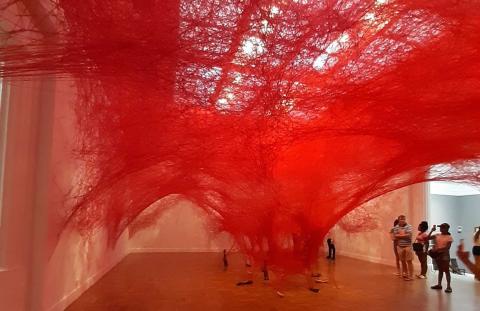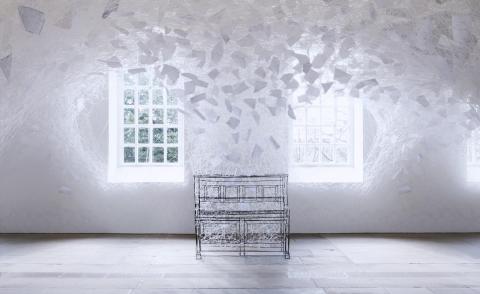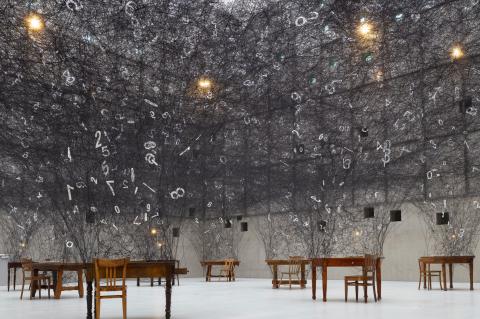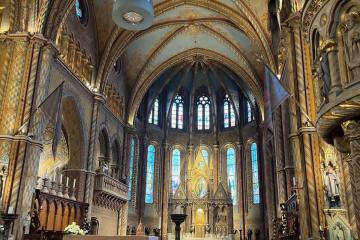After careful thought, we will be discontinuing the Music Monthly newsletter.
TANGLED WEBS
TANGLED WEBS
4 Jun 2020
Last December I was fortunate to be in Adelaide and encountered an intriguing installation by the Japanese artist Chiharu Shiota. The artist, her two assistants and the Art Gallery of South Australia’s own installation team worked around the clock, seven days a week, for three weeks to create the specially commissioned work, Absence Embodied. “An installation is about the moment,’’ said Shiota, 46, “It has the power to evoke the meaning of life and death for the audience.”
Absence Embodied is a construction that one can walk into, a drawing in space, spun using 180 kilometres of red string, tent-like in outline and anchored at ground points by bronze casts of Shiota’s and plaster casts of her daughter’s lower arms. The experience is so “of the moment,” I couldn’t even position my phone at an angle to take a picture that would work as a memory-jogger. It is the emotional aftermath that remains, and the memory of hands, as though recalling a medical emergency.
Blood, the most obvious reference point, is ever-present in her use of red. But also, in Chinese, Korean and Japanese belief systems, the red thread of fate, or of marriage (and so interpersonal connections, is a staple. Eternity and the unfathomable night sky are conjured in her use of black. While white is Japan’s polar opposite of the Western “colour” of mourning.
Shiota is an artist who has overcome personal and national boundaries and worked her way to the core of what it means to be human. She emerged from a period of stasis in her study of painting while on a student exchange to the Canberra School of Art in 1994. Her performance Becoming Painting proved a watershed in opening up possibilities for giving expression to the inner life: she dreamed that she was in a painting and, the next day, wrapped herself in canvas and red paint, poisoning herself in the process but gaining her direction in art.
Thus Absence Embodied is the visual expression of her experience of having one’s body subjected to analysis and procedures, inducing a state of being dis-embodied, where the inner capillaries, organs and bones compete with a sense of body as defined by its outer shell. This line of investigation has introduced notions of the body as an effigy or a second skin. This ‘second skin’ concept has found some extraordinary expressions, including a series of dresses, some extending to the ground from a fourth storey window (see here: https://www.chiharu-shiota.com/dialogue-with-absence-jp-1) and others (Memory of Skin https://www.chiharu-shiota.com/memory-of-skin-jp ) soiled with mud and subjected to ineffectual cleansing.
When she was nine, Shiota saw the burnt-out, soundless remains of her neighbour’s piano after a house fire. The image stayed with her. Now, it has inspired a haunting new work, rendered in her preferred medium, webs of twisted thread. Emitting from a cast iron piano in the centre of the space, like a visual manifestation of sound, a complexity of white threads entangles hundreds of sheets of paper. From afar, it’s a hurricane in a printworks. Look closely and you’ll see that each sheet is uniquely printed with writing and score.
‘Beyond Time’ – an immersive installation spun from the flagstones to the rafters in the deconsecrated, 18th-century chapel at Yorkshire Sculpture Park – is divergent from Shiota’s previous works, in that it uses pure, white thread instead of the gothic reds and blacks she earlier favoured. Traditionally, white represents mourning in Japan, but for Shiota, it has a connection to ‘eternity’; her belief that entering into death is just another phase of being.
It was the chapel’s absence of a musical instrument that first inspired Shiota to create the installation, and the silence of the space remains tangible. There’s rigidity in the unplayable black steel keys of the piano; a quietude from the visitors contemplatively milling, stillness in the papers that are snapshot-suspended, mid-flight. This silence adds to the performative quality of the installation. Trained by Marina Abramović in Berlin, Shiota began her career as a performance artist, inspirations from which linger in the webs – a sensory explosion.
Counting Memories is a site-specific installation made by Shiota for the Silesian Museum. A web of black yarn engulfs the viewer upon entering the space (3000 skeins of yarn with a total length of 375 km). It extends from the ceiling and then funnels down into nine wooden tables and chairs scattered throughout the room. The black yarn thus represents the night sky, cosmos, and universe. While scattered throughout are white numbers.
This is certainly an interactive experience. She invites visitors to sit at the desks and respond to questions written on paper for example. These questions echo the numbers floating above and as a result focus on the importance of numbers in our lives.
Which number has meaning to you and why?
Do numbers tell us who we are?
How many memories do you have?
What is the most important number?
What number defines you?
Do numbers tell the truth?
How many stars exist in the universe?
When do numbers stop making sense?
Why do memories and numbers have a connection?
What is our common denominator as people?
The artwork is a reflection on what makes us human and how our memories build our identity, all within the context of the region of Upper Silesia. In the artist's own words, 'The interconnected string displays our connected history. Each number defines us individually but also connects us universally. Numbers comfort us, we share dates that are important to us, and they help us understand ourselves. Our history is collected through numbers. In this way, the intertwined string reflects our history, while the numbers, which are scattered sporadically like the stars above Katowice, represent the most meaningful dates we know.'
Constricting and completing a space, transcending linguistic, cultural, and historical contexts and socio-political conditions, Shiota’s work has made a deep impression on viewers all around the world. Ever since she represented her work The Key in the Hand (2015) at the Japanese pavilion at the Venice Biennale, giant networks made of yarn have become a trademark of Shiota’s art. Sometimes Shiota asks the public to help her collect materials, engaging people to become part of her work, with their belongings as well as their memories. For The key in hand, Shiota collected over 1,800,000 keys - 50,000 were used for the final artwork. The artist searches for her identity through the unidentified sourced material that stores so many intangible memories See the work here: https://www.youtube.com/watch?v=NDfuq8zJXCg
My encounter with Shiota’s work in the truly immersive installation in Adelaide leads me to commend her work to anyone interested in exploring how art can resonate with modern audiences seeking to connect with the human experience.
Illustrations:
Chiharu Shiota, Absence Embodied in the Melrose Wing at the Art Gallery of SA. Photo by Jeni Fraser, December 2019,
Beyond Time, 2018, by Chiharu Shiota, © The artist and VG Bild-Kunst, Bonn. Courtesy of Yorkshire Sculpture Park. Photography: Jonty Wilde
Counting Memories, installation at the Silesian Museum, Katowice, Poland 2019-2020
About the Author
Jeni Fraser
JOIN OUR MAILING LIST
Become an instant expert!
Find out more about the arts by becoming a Supporter of The Arts Society.
For just £20 a year you will receive invitations to exclusive member events and courses, special offers and concessions, our regular newsletter and our beautiful arts magazine, full of news, views, events and artist profiles.
FIND YOUR NEAREST SOCIETY
MORE FEATURES
More than twenty members of our Arts Society flew out in October 2025 for a short but fascinating trip discovering th
Year in Review: A Remarkable Year for The Arts Society Mallorca







